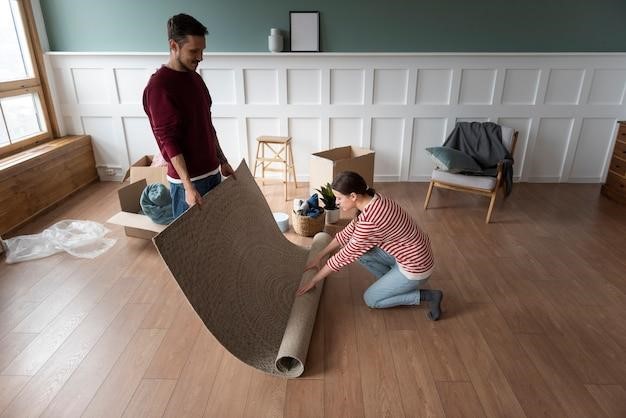Luxury Vinyl Tile (LVT) is widespread in high-traffic commercial spaces owing to its durability and aesthetic adaptability. The two main installation techniques, click and glue down LVT, satisfy different application needs. Click systems are readily reconfigurable and install quickly without adhesives.
Conversely, glue down LVT bonds permanently to the subfloor for places that need solidity. These techniques affect project timeframes, budgets, and long-term maintenance plans. Moreover, it highlights their technical and practical relevance in contemporary flooring projects.
LVT Floor in the Flooring Markets
LVT flooring uses creative construction technology to overlay a high-resolution printed image between a transparent coat and a durable vinyl core. It replicates many natural materials, including hardwood, stone, and ceramic, without downsides (e.g., water damage, costly maintenance, and installation difficulty) and boosts durability. The wear layer thickness in mils affects the floor’s capacity to endure scratches, scuffs, and stains in high-traffic areas. Fiberglass in the core layer aids dimensional stability while limiting temperature-induced expansion and contraction.
LVT’s click-lock, glue-down, and loose-lay installation techniques make it versatile for professional and DIY installation. Because of its dense core and optional integrated acoustic underlayment, LVT dampens multi-story building noise. Many LVT products are recycled and recyclable in sustainable architecture. After these progressions and environmental concerns, LVT flooring is positioned for greater acceptance in residential, commercial, and industrial sectors due to its higher performance metrics and green construction requirements.
Defining Click and Glue Down LVT
Click LVT lock tiles edge-to-edge without adhesives while abridging installation and permitting floating over existing floors.
Yet, glue-down or dry-back LVT binds to the subfloor using a specific adhesive. It creates a strong bond that tolerates heavy traffic and dampness. It also offers elaborate pattern designs and flawless finishes for better cosmetic and practical appeal.
So, click LVT is fast and flexible, but glue-down LVT is durable and precise for commercial and high-moisture locations.
Comparison between Both of these Techniques
- Installation Method
Click LVT is intended for floating floor installation, unlike glue-down LVT, which calls for a direct, adhesive bond with the subfloor. This fundamental difference affects installation difficulty and preparation. For instance, click LVT may be laid over existing flooring without subfloor preparation. It renders installation faster and cheaper. Nevertheless, glue-down LVT needs well-prepared flooring, including leveling and priming, to avoid peeling or lifting.
- Thickness
Glue-down LVT has thinner profiles than click LVT due to its direct adhesive method with less structural bulk. For installations with minimum floor height, glue-down LVT’s 2-3mm thickness might be helpful. Click LVT products are thicker (5–6mm) and provide more insulation and comfort. It impacts the flooring’s feel, thermal qualities, and aptness for revamping or construction.
- Wear-Resistance
LVT wear resistance relies on the wear layer’s thickness and material composition, not the installation method. However, gluing down LVT’s adhesive bond could make it wear-resistant under high usage. Both click and glue-down LVT are wear-resistant, but glue-down LVT’s direct attachment to the subfloor averts shifting and wear in commercial locations with great foot traffic.
- Price
Due to material thickness and installation costs, glue-down LVT costs less than click LVT. Yet, the total cost of ownership should also consider the installation labor. It is higher for glue down LVT due to subfloor preparation. Glue down LVT installation also takes longer, which might raise labor expenses despite the low material cost. Click LVT systems are quicker and simpler to install.
- Conditioning Time
Conditioning time allows the flooring material to adjust to the installation environment’s temperature and humidity before installation. Glue down LVT’s smaller profile, which adapts faster to environmental conditions than clicking LVT. The shorter conditioning time speeds installation and project turnaround. In addition, glue-down LVT adhesive includes ambient condition requirements. It highlights the value of adequate acclimation to avoid installation difficulties.
- Flexibility
Flexibility is the flooring’s capacity to lodge subfloor abnormalities and different installation methods. Because of its fragile profile and direct adhesive application, glue-down LVT is less flexible than clicking LVT. Thickness and interlocking structure allow the latter to tolerate slight subfloor irregularities. However, glue-down LVT is adaptable for complicated designs and patterns where exact alignment and the ability to cut and adjust tiles are essential for the desired look.
| Characteristic | Click LVT | Glue Down LVT |
| Installation Method | Intended for floating floor installation | Requires direct adhesive bond with the subfloor |
| Thickness | Thicker (5–6mm) for insulation and comfort | Thinner (2-3mm) for minimum floor height and less bulk |
| Wear-Resistance | Depends on wear layer thickness and material | Wear-resistant due to adhesive bond, especially under high usage |
| Price | Higher due to thicker material and easier installation | Lower material cost but higher labor cost due to preparation |
| Conditioning Time | Longer due to thicker material | Shorter due to thinner profile and quicker adaptation |
| Flexibility | More flexible to tolerate subfloor irregularities | Less flexible due to direct adhesive application |
Conclusion
Boyu Company has strived to become the elite flooring plastic extruder or plastic extrusion machine partner for PVC flooring manufacturing. Boyu has forged breakthroughs, including the CE-certified conical twin-screw extruder, for over 20 years. The highest industry requirements are met by their LVT flooring, which is durable, waterproof, and eco-friendly. Boyu’s over 90 scientific patents and devotion to R&D render them a trusted flooring manufacturing technology partner.

